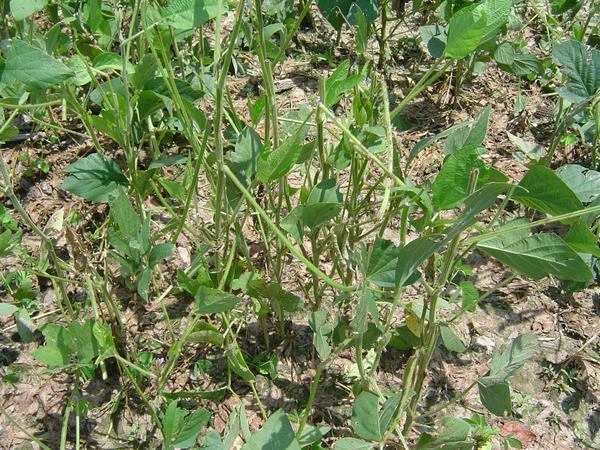Introduction
Hail damage can occur at any point in the soybean season and the severity of the damage depends on the type of injury, soybean growth stage when injured, and the remaining plant population. Types of injury can include stand loss, defoliation, stem damage, and pod damage. Soybeans are most susceptible to injury at early growth stages. If soybeans are in the crook stage, hail hitting the hypocotyl arch can cause the cotyledons to break off and those seedlings to die. After soybeans have fully emerged, even if a hailstorm broke off one cotyledon the plants have the opportunity to recover by sending new growth out the axillary buds at the cotyledonary nodes. The more vegetative growth on the soybean plants, the more likely the plants are to survive the hail event. Soybeans have the opportunity to send out new growth from all the axillary buds at the juncture where the stem meets the leaf. Soybeans have an incredible ability to compensate for early season injury through production of new vegetation.
Symptoms
Early season symptoms of hail damage can include snapped hypocotyls in the crook stage, reduced stand, and missing cotyledons. As the plant gets larger, hail damage can cause defoliation and stem damage. Stem damage can include cracked and bent stem. If there is stem damage, that could lead to a great likelihood of lodging at harvest. Although rare, pod damage or loss can occur.
Management
There is nothing a producer could do to prevent hail damage from occurring in their soybean fields, however once hail damage has occurred there are several management strategies that can be used on those fields.
If early season hail damage occurs, A producer should wait 3-5 days after the damage to assess soybean stand. That provides the soybean plant with time to recover. Once the producer has waited several days, soybean stand should be accurately assessed before making decisions about soybean replanting. The producer should look for healthy new tissue emerging from the apical and axillary meristems in order to count that plant in the final remaining population.
Subsequent pest management will be important in hail damaged fields. Weed control will be important as canopy reductions from hail damage could result in reduced competitiveness with weeds. Fields should be scouted and managed for disease and insects to protect the remaining canopy.
Additional Resources
Hail damage to soybean crops (University of Minnesota Extension)
Evaluating Hail Damage to Soybeans (University of Nebraska-Lincoln Extension)
Publication date: June 1, 2020
N.C. Cooperative Extension prohibits discrimination and harassment regardless of age, color, disability, family and marital status, gender identity, national origin, political beliefs, race, religion, sex (including pregnancy), sexual orientation and veteran status.
NC Cooperative Extension prohíbe la discriminación por raza, color, nacionalidad, edad, sexo (incluyendo el embarazo), discapacidad, religión, orientación sexual, identidad de género, información genética, afiliación política, y estatus de veteran.
The use of brand names in this publication does not imply endorsement by NC State University or N.C. A&T State University of the products or services named nor discrimination against similar products or services not mentioned.
Recommendations for the use of agricultural chemicals are included in this publication as a convenience to the reader. The use of brand names and any mention or listing of commercial products or services in this publication does not imply endorsement by NC State University or N.C. A&T State University nor discrimination against similar products or services not mentioned. Individuals who use agricultural chemicals are responsible for ensuring that the intended use complies with current regulations and conforms to the product label. Be sure to obtain current information about usage regulations and examine a current product label before applying any chemical. For assistance, contact your local N.C. Cooperative Extension county center.
N.C. Cooperative Extension prohibits discrimination and harassment regardless of age, color, disability, family and marital status, gender identity, national origin, political beliefs, race, religion, sex (including pregnancy), sexual orientation and veteran status.


